Comparative whole-genome transcriptome analysis in renal cell populations reveals high tissue specificity of MAPK/ERK targets in embryonic kidney
- PMID: 35550069
- PMCID: PMC9102746
- DOI: 10.1186/s12915-022-01309-z
Comparative whole-genome transcriptome analysis in renal cell populations reveals high tissue specificity of MAPK/ERK targets in embryonic kidney
Abstract
Background: MAPK/ERK signaling is a well-known mediator of extracellular stimuli controlling intracellular responses to growth factors and mechanical cues. The critical requirement of MAPK/ERK signaling for embryonic stem cell maintenance is demonstrated, but specific functions in progenitor regulation during embryonic development, and in particular kidney development remain largely unexplored. We previously demonstrated MAPK/ERK signaling as a key regulator of kidney growth through branching morphogenesis and normal nephrogenesis where it also regulates progenitor expansion. Here, we performed RNA sequencing-based whole-genome expression analysis to identify transcriptional MAPK/ERK targets in two distinct renal populations: the ureteric bud epithelium and the nephron progenitors.
Results: Our analysis revealed a large number (5053) of differentially expressed genes (DEGs) in nephron progenitors and significantly less (1004) in ureteric bud epithelium, reflecting likely heterogenicity of cell types. The data analysis identified high tissue-specificity, as only a fraction (362) of MAPK/ERK targets are shared between the two tissues. Tissue-specific MAPK/ERK targets participate in the regulation of mitochondrial energy metabolism in nephron progenitors, which fail to maintain normal mitochondria numbers in the MAPK/ERK-deficient tissue. In the ureteric bud epithelium, a dramatic decline in progenitor-specific gene expression was detected with a simultaneous increase in differentiation-associated genes, which was not observed in nephron progenitors. Our experiments in the genetic model of MAPK/ERK deficiency provide evidence that MAPK/ERK signaling in the ureteric bud maintains epithelial cells in an undifferentiated state. Interestingly, the transcriptional targets shared between the two tissues studied are over-represented by histone genes, suggesting that MAPK/ERK signaling regulates cell cycle progression and stem cell maintenance through chromosome condensation and nucleosome assembly.
Conclusions: Using tissue-specific MAPK/ERK inactivation and RNA sequencing in combination with experimentation in embryonic kidneys, we demonstrate here that MAPK/ERK signaling maintains ureteric bud tip cells, suggesting a regulatory role in collecting duct progenitors. We additionally deliver new mechanistic information on how MAPK/ERK signaling regulates progenitor maintenance through its effects on chromatin accessibility and energy metabolism.
© 2022. The Author(s).
Conflict of interest statement
The authors declare that they have no competing interests.
Figures
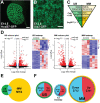
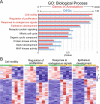
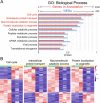
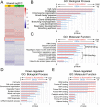
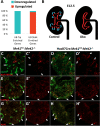
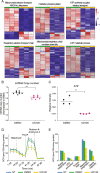

Similar articles
-
Omics profiling identifies the regulatory functions of the MAPK/ERK pathway in nephron progenitor metabolism.Development. 2022 Oct 1;149(19):dev200986. doi: 10.1242/dev.200986. Epub 2022 Oct 3. Development. 2022. PMID: 36189831 Free PMC article.
-
Genetic manipulation of ureteric bud tip progenitors in the mammalian kidney through an Adamts18 enhancer driven tet-on inducible system.Dev Biol. 2020 Feb 15;458(2):164-176. doi: 10.1016/j.ydbio.2019.11.007. Epub 2019 Nov 14. Dev Biol. 2020. PMID: 31734175 Free PMC article.
-
Dynamic MAPK/ERK Activity Sustains Nephron Progenitors through Niche Regulation and Primes Precursors for Differentiation.Stem Cell Reports. 2018 Oct 9;11(4):912-928. doi: 10.1016/j.stemcr.2018.08.012. Epub 2018 Sep 13. Stem Cell Reports. 2018. PMID: 30220628 Free PMC article.
-
MAPK/ERK Signaling in Regulation of Renal Differentiation.Int J Mol Sci. 2019 Apr 10;20(7):1779. doi: 10.3390/ijms20071779. Int J Mol Sci. 2019. PMID: 30974877 Free PMC article. Review.
-
Kidney development at a glance: metabolic regulation of renal progenitor cells.Curr Top Dev Biol. 2025;163:15-44. doi: 10.1016/bs.ctdb.2024.11.009. Epub 2024 Dec 10. Curr Top Dev Biol. 2025. PMID: 40254344 Review.
Cited by
-
Nephron progenitors rhythmically alternate between renewal and differentiation phases that synchronize with kidney branching morphogenesis.bioRxiv [Preprint]. 2024 Jan 13:2023.11.21.568157. doi: 10.1101/2023.11.21.568157. bioRxiv. 2024. PMID: 38045273 Free PMC article. Preprint.
-
Integrating collecting systems in human kidney organoids through fusion of distal nephron to ureteric bud.Cell Stem Cell. 2025 Jul 3;32(7):1055-1070.e8. doi: 10.1016/j.stem.2025.04.008. Epub 2025 May 8. Cell Stem Cell. 2025. PMID: 40345193
-
Omics profiling identifies the regulatory functions of the MAPK/ERK pathway in nephron progenitor metabolism.Development. 2022 Oct 1;149(19):dev200986. doi: 10.1242/dev.200986. Epub 2022 Oct 3. Development. 2022. PMID: 36189831 Free PMC article.
References
Publication types
MeSH terms
LinkOut - more resources
Full Text Sources
Molecular Biology Databases
Miscellaneous

